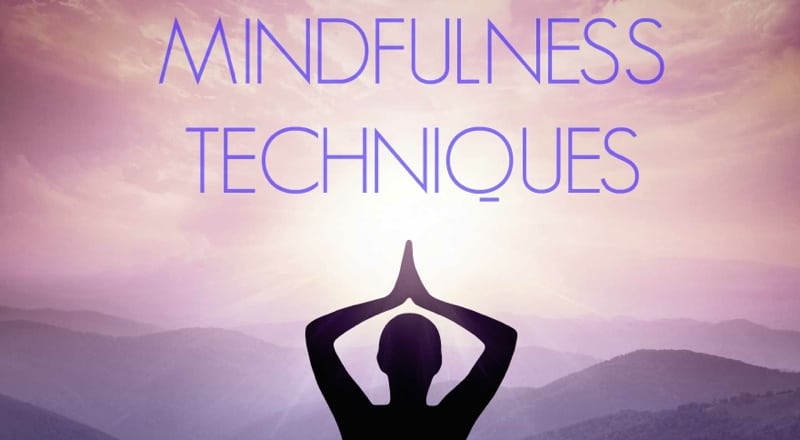Mindfulness techniques have found new ground in consumerist societies and as a result, people are learning to be consciously in the moment, often for the first time in their lives.
The truth of the matter is that mindfulness techniques have existed for centuries and many ways to engage have naturally developed. Good news: Most mindfulness techniques are either free and relatively easy to learn.
Mindfulness is being able to hold one’s conscious attention in the present moment. To anchor ourselves to the present moment, we may focus on anything from our breath to our thoughts to our emotions to the outside world to even the color blue.
As there are many personalities, there are many ways to practice and achieve mindfulness. Each of these ways is worth a try until you discover the way that is easiest for you.
Mindfulness Technique #1: Practicing Acceptance
Acceptance may be the queen of all mindfulness techniques. Of course, people naturally desire things in their lives. If we pause for a moment, we may realize that we can tell the story of our lives through the prism of ceaseless desires and our failures or successes while striving for them.
Buddha himself noted an endless deluge of desires, that are mostly unattainable in the brevity of life, is largely responsible for the suffering we feel. Acceptance is one antidote to this problem.
Acceptance is not the rejection of worthy goals and desires. Instead, it is the realization that we may or may not achieve those goals and desires and that the outcomes have no effect on the nature of our being.
For example, failure does not make you a bad person. Acceptance depersonalizes the outcomes of our desires and allows us to maintain and build self-confidence. Acceptance is a tool to appreciate what we do have and in so doing, we will become mindful. The mind often rushes to what is not there while acceptance yokes the mind back to what is here and now – an invitation to appreciate each moment.
Mindfulness Technique #2: Eating Mindfully
Eating mindfully is useful among mindfulness techniques for a few reasons. First, it provides a framework for when to practice mindfulness. This technique is used by monks the world over because it helps promote practice.
One of the initial problems implementing mindfulness techniques is that we are trying to alter permanently, habits which we have developed over the course of decades (namely, to let our mind run unrestrained wheresoever it desires). Making a practice of eating when mindful gives us a context and a trigger in our minds. Over time, it will become instinctive to be mindful as we eat.
A second benefit of being mindful during a meal is that is makes you prone to eat appropriately. When you observe every bite, including the sounds, textures, and tastes of your food, you inevitably slow down the rate at which you eat. A slower pace of eating has been scientifically demonstrated to lead to smaller amounts of food being eaten overall. We also enjoy our meal more and this increases the aesthetic appreciation we have of our world. It is the cumulative effect of these benefits that make for big changes down the road.
Mindfulness Technique #3: How To Begin Your Day
Another trigger habit that we can incorporate into our lives that has large gains in mindfulness is the practice of beginning our day without any technological assistance.
Perhaps, we may need the alarm clock initially (although it is entirely possible to train ourselves to wake up reliably at a certain time everyday). When we wake up and do not immediately rush to our phone or turn on the television or listen to the radio, we have to come to recognize our immediate environment.
Instead of mentally transporting yourself all over the world with the whim of news stories or through a range of emotional environments, use the opportunity to take your first step of the day into the calm of immediate surroundings.
This is a powerful practice because it makes us pause and appreciate what we have. There is a time for our technological tools, but the start of our day can become a sacred moment in our day where we gain an appreciation for the world and develop a positive attitude and introspective, learning perspective – before we step into the flow of a fast-paced world.
There are countless mindfulness techniques and ways in which we can become mindful, but these three (especially when combined) can lead to routine and deepening mindfulness experiences.
Get daily mindfulness tips at Mindfulness Advice on Facebook.
How Does Mindfulness Reduce Anger, Mindfulness Against Anger, Mindfulness And Anger, Mindfulness And Anger Management, Mindfulness Anger, Mindfulness Anger Management, Mindfulness Anger Management Techniques, Mindfulness For Anger Management Book, Mindfulness In Anger, Mindfulness In Anger Management, Mindfulness Meditation And Anger Management, Mindfulness Techniques Anger, Mindfulness To Reduce Anger, Mindfulness Training Anger Management, Mindfulness With Anger
